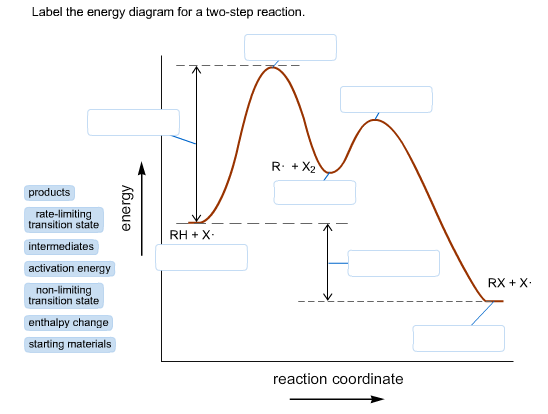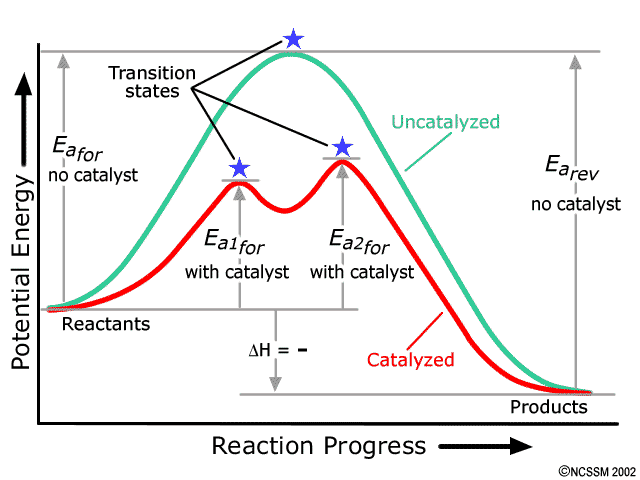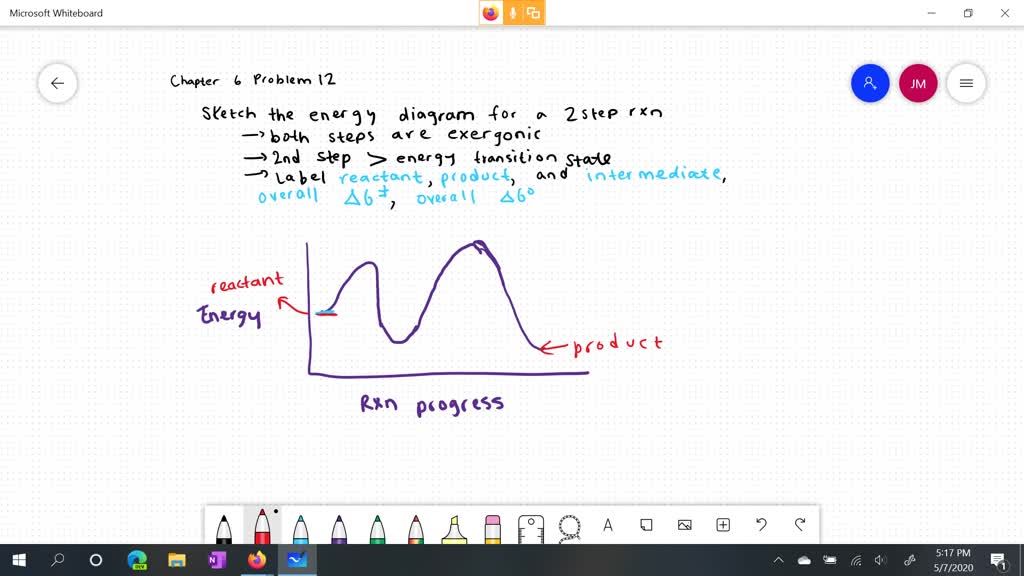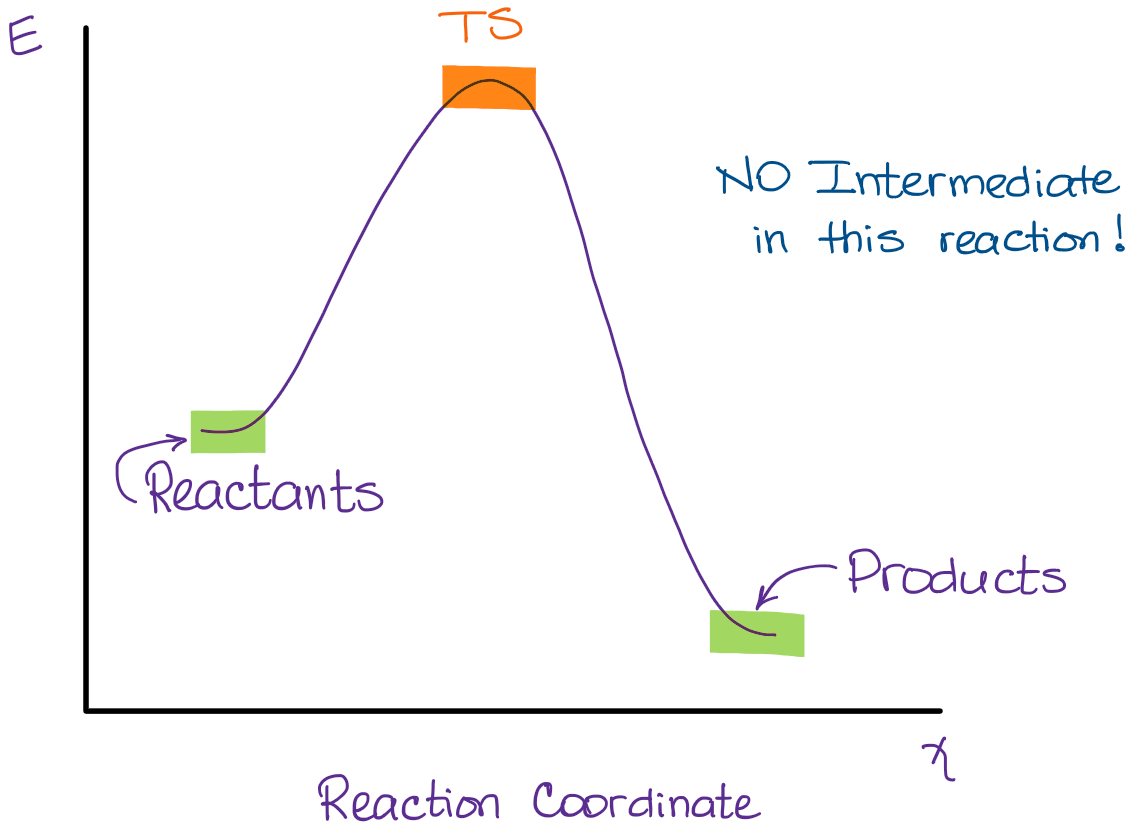39 label the energy diagram for a two-step reaction.
Krebs cycle / Citric acid cycle / TCA Cycle with steps and diagram This reaction, like the second reaction, is a two-step reaction. In the first step, isocitrate is dehydrogenated to oxalosuccinate while the second step involves the decarboxylation of oxalosuccinate to α-ketoglutarate. Both the reactions are irreversible and catalyzed by the same enzyme. Cellular Respiration Equation, Types, Stages, Products & Diagrams Glycolysis is referred to as a "ten enzyme-catalyzed reaction" but the overall simplified equation is: C6H12O6 + 2 NAD+ + 2 ADP + 2 P → 2 pyruvic acid, (CH3(C=O)COOH + 2 ATP + 2 NADH + 2 H+ While the above equation shows that glycolysis produce two ATP molecules, four molecules are actually produced during the entire process.
Electrochemistry Basics - Chemistry LibreTexts Method 2: Half-Reaction Method. Step 1: Determine oxidation numbers for each atom. Step 2: Use oxidation numbers to determine what is oxidized and what is reduced. Step 3: Write a half-reaction for reduction. Step 4: Write a half-reaction for oxidation. Step 5: Balance all elements except H and O.

Label the energy diagram for a two-step reaction.
How to Draw & Label Enthalpy Diagrams - Study.com In drawing an enthalpy diagram we typically start out with the simplest part first, the change in energy. Let's say that we're looking at the chemical reaction of methane and oxygen burning into... 6.E: An Overview of Organic Reactions (Exercises ... - Chemistry LibreTexts Draw an energy diagram with a exergonic first step and an endergonic second step. Label the diagram. Solutions S6.10.1 6.11 A Comparison Between Biological 6.E: An Overview of Organic Reactions (Exercises) is shared under a not declared license and was authored, remixed, and/or curated by LibreTexts. Biochemistry, Electron Transport Chain - NCBI Bookshelf Step 1 in the Q cycle involves ubiquinol (CoQH2) and ubiquinone (CoQ) binding to two separate sites on complex III. CoQH2 transfers each electron to a different path. One electron goes to Fe-S and then cytochrome c, while the second electron is transferred to cytochrome b and then to CoQ bound at the other site.
Label the energy diagram for a two-step reaction.. Glycolysis : All Steps with Diagram, Enzymes, Products, Energy Yield ... ADP and NAD stand for Adenosine diphosphate and Nicotinamide adenine dinucleotide, respectively. Steps of Glycolysis Glycolysis is a lengthy process. It has the following steps. Step 1 : Uptake and Phosphorylation of Glucose Glucose is phosphorylated to form glucose-6-phosphate. Hexokinase Phosphate group is transferred from ATP to Glucose. How electroplating works - Explain that Stuff The Microsmooth™ process uses about 30 percent less electricity, nearly 60 percent less natural gas, and half the water that conventional plating processes need. Photo by Metal Arts Company, Inc. courtesy of US Department of Energy (DOE). Electroplating is generally done for two quite different reasons: decoration and protection. Chapter 2 - Alcohols, Phenols, Thiols, Ethers - CHE 120 - Introduction ... Write the equation for the reaction of 2-butene with water to form 2-butanol. Indicate that sulfuric acid is used as a catalyst. ... Enzyme-controlled oxidation reactions provide the energy cells need to do useful work. One step in the metabolism of carbohydrates involves the oxidation of the secondary alcohol group in isocitric acid to a ... What Is the Chemical Equation for Cellular Respiration? 4. Oxygen is a gas that assists in cellular respiration by reacting with glucose to produce a usable form of energy. 5. In cellular respiration,12 oxygen atoms in the glucose molecule are balanced ...
Chemistry WCH11 2022 Exam (videos, questions, solutions) Step 1 A crucible was weighed, a spatula measure of hydrated magnesium sulfate was added and the crucible was reweighed. Step 2 The crucible containing the hydrated magnesium sulfate was heated using the apparatus shown. Step 3 After heating for two minutes, the crucible containing the magnesium sulfate was allowed to cool and was reweighed. Lewis Structures: Learn How to Draw Lewis Structures | Albert.io Since Fluorine is in Period 2, it can fit a maximum of eight (8) electrons second energy level. Fluorine Group VII, which means it has a total of seven (7) valence electrons around the atom. Example 3. Draw the Lewis Dot Structure for Oxygen. Since Oxygen is in Period 2, it can fit a maximum of eight (8) electrons second energy level. Venn Diagram: Definition, Symbols, How to Draw with Examples Venn Diagram for Two Sets As the name suggests, the diagram involves two sets. Consider the diagram to understand the same. The elements for such a set are categories within two groups and depending on the relation the diagram is drawn. Here one set is P (the left circle) and the other is Q (the right circle). 6.10: Describing a Reaction- Intermediates - Chemistry LibreTexts A potential energy diagram for an S N 1 reaction shows that the carbocation intermediate can be visualized as a kind of valley in the path of the reaction, higher in energy than both the reactant and product but lower in energy than the two transition states. Exercise 6.10.2 Draw structures representing TS1 and TS2 in the reaction above.
Metabolism Pathways-Examples, Diagrams, and Overview This process occurs in two steps when oxygen is added to the ammonia molecule, and then another nitrogen group is added to form a ring. OR NH3 + O -> HO2- + NH2 (amine) HO2- -> H+ + O2 Figure: Deamination of amino acids The next step in the process is phosphorylation, which occurs when ATP adds a phosphate group to an amino acid. The standard free energy of a reaction At 25 oC, ∆G°= 553 J ... - Jiskha In the following reaction, the energy of the reactants is 1240 kj/mol, and the bond energy of the products is 790 kj/mol. What is the total energy of the reaction? Is the reaction enothermic or exothermic? A 2030 kj/mol, Chemistry. A reaction A(aq)+B(aq)C(aq) has a standard free-energy change of -3.35 kJ/mol at 25 °C. Photosynthesis Diagram - Explore the Secret of Nature In this phase of photosynthesis energy loses along the electron transport chain to recharge ATP from ADP. During this process, light energy gets converted into chemical energy and finally ATP molecules are produced. This reaction is also known as light-dependent reaction. 2. Photosynthesis Dark Reaction: ATP + NADPH + CO2 → ADP + NADP + glucose Biochemistry, Ketogenesis - StatPearls - NCBI Bookshelf Ketogenesis is a metabolic pathway that produces ketone bodies, which provide an alternative form of energy for the body. The body is constantly producing small amounts of ketone bodies that can make 22 ATP each in normal circumstances, and it is regulated mainly by insulin. In a state of ketosis, ketone body production is increased when there are decreased carbohydrates or increased fatty ...
Jablonski diagram - Chemistry LibreTexts A Jablonski diagram is basically an energy diagram, arranged with energy on a vertical axis. The energy levels can be quantitatively denoted, but most of these diagrams use energy levels schematically. The rest of the diagram is arranged into columns. Every column usually represents a specific spin multiplicity for a particular species.
Phase Diagrams: Critical Point, Triple Point and Phase Equilibrium ... A phase diagram is a graph of the physical state of a substance (solid, liquid or gas) and the temperature and pressure of the substance. Phase diagrams are unique to every different substance.
Schematic Diagram - A Complete Tutorial with Free Examples | EdrawMax Purpose and Benefit. The main purpose of a schematic diagram is to give an overview of a complete project with the help of simple icons and lines. Since these shapes are general, even inexperienced engineers can read the chart easily and can take the plan to the practical phase. Keeping in mind the electrical and electronics field, the benefit ...
Energy Diagrams of Reactions | Fiveable To find the activation energy, you should be looking for two numbers: the potential energy of the reactants and the energy of the activated complex (the maximum point). (energy of activation complex) - (PEreactants) (100 kJ) - (40 kJ) = 60 kJ In other words, it takes 60 kJ of energy to complete the reaction.
Feynman diagram - Wikipedia In theoretical physics, a Feynman diagram is a pictorial representation of the mathematical expressions describing the behavior and interaction of subatomic particles.The scheme is named after American physicist Richard Feynman, who introduced the diagrams in 1948.The interaction of subatomic particles can be complex and difficult to understand; Feynman diagrams give a simple visualization of ...
6.9: Describing a Reaction - Energy Diagrams and Transition States In an energy diagram, the vertical axis represents the overall energy of the reactants, while the horizontal axis is the ' reaction coordinate ', tracing from left to right the progress of the reaction from starting compounds to final products. The energy diagram for a typical one-step reaction might look like this:
Energy Transformation: Definition, Types & Examples - Study.com Follow the steps below to observe some real life examples of energy transformation, then create two on your own. Example 1: Hot Water Start by putting a pot of water on the stove. Next, turn on the...
Chapter 11 - Metabolic Pathways and Energy Production - CHE 120 ... The hydrolysis of ATP releases energy that can be used for cellular processes that require energy. Exercises 1. How do ATP and ADP differ in structure? 2. Why does the hydrolysis of ATP to ADP involve the release of energy? 3. Identify whether each compound would be classified as a high-energy phosphate compound. a. ATP b. glucose 6-phosphate







Post a Comment for "39 label the energy diagram for a two-step reaction."